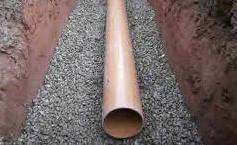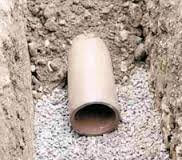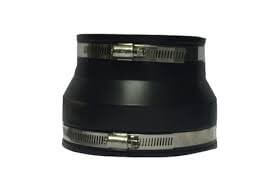Comparing PVC Drainage To Other Materials (Video)
Can I use PVC pipe for drainage?
Most domestic drainage installations in the UK use PVC pipe, due to its excellent flow rate, lightweight and relatively low cost compared to other materials. PVC Drainage pipe is easily recognisable by its colour – terracotta orange. Drainage pipe in the UK is generally manufactured to BS 4660 or BS EN 1401 – most underground drainage pipes manufactured to this standard are interchangeable.
Until the last quarter of the 20th Century and before the widespread adoption of plastic as a drainage material, underground drainage pipes and fittings were made from vitreous clay, cast iron, pitch fibre or asbestos cement.
Whilst the majority of the products are no longer used for this application, clay drainage is still produced in the UK and it is still favoured by some developers.
What are drainage pipes made of?
Most domestic drainage pipes are now made from plastic, or PVC-U to use the proper term. PVC-U pipes are lighter and easier to handle than traditional clay drains. Clay drainage is still used on some commercial installations.
Plastic drainage pipes can be either plain ended or socketed on one end. One of the major advantages of plastic drainage pipes is that they are much easier to cut and join than clay pipes, this can be done using a standard fine toothed handsaw. A rasp or file should be used to chamfer the end of the pipe when it has been cut to avoid any damage to the seal when a joint is made.


How long do PVC pipes last underground?
Whilst this depends on the exact composition of the surrounding soil, any PVC underground drainage pipe manufactured to BS4660 or BS EN 1401 should last in excess of 50 years.
The life of any drainage system will be prolonged by a good installation and maintenance when required – slow flows, gurgling sounds from the sink, bath or shower or foul odours in the house or garden are all symptomatic of a blocked drain and should be investigated as soon as they occur.
So what is the best underground drainage pipe?
Both PVC and clay have their supporters, but plastic is by far the most popular underground drainage material in use today in the UK construction industry. PVC pipes are much lighter and hence easier to handle on site - builders merchants favour it for exactly the same reason. PVC is a hardy material – it is not fragile and unlike clay it is actually quite difficult to damage, with an excellent strength to weight ratio. Plastic pipes are simple to cut, needing nothing more than a fine-toothed saw whereas clay drainage requires the use of cutting discs or more specialist tools.
PVC Drainage pipe has smooth walls, with minimal friction delivering excellent flow rates when compared to the natural finished surface of a clayware pipe. Whilst all PVC manufacturers’ fittings and pipes differ in size by fractions of millimetres, all British Standard approved plastic drainage systems are manufactured within specific size tolerances, meaning that all such approved systems can be interconnected without the need for adaptors, saving any confusion when connecting into existing systems.
So in summary, whilst clay drainage pipes are still occasionally used for new drainage installations, by far the most commonly used material used in the UK is PVC-U. PVC-U is lightweight, long lasting and robust. The walls of a PVC pipe are extremely smooth, promoting a healthy flow of the materials within the pipe. PVC drainage pipes are resistant to high temperatures and most acids and alkalis. Take a look at our 110mm drainage for more info.
Does Clay Drainage Have Any Advantages Over PVC?
Because it is such a heavy material, clay pipes do not deform when buried underground, meaning that less bedding material (pea shingle) is required. Whilst plastic is a strong material, the relative thinness of the pipe wall when compared to clay means that more shingle is needed as bedding and backfill material.
Clay could also be considered to be a more “green” material if this is a consideration in your build project.
Can New PVC Drainage Pipes Be Connected To An Old Clay System?
Yes. There are various ways of achieving this but the simplest way is to use our flexible connectors, which utilises stainless steel clips to provide a permanent watertight seal.

Please take two minutes to watch our short instructional video on how to join PVC and Clay pipes together.







